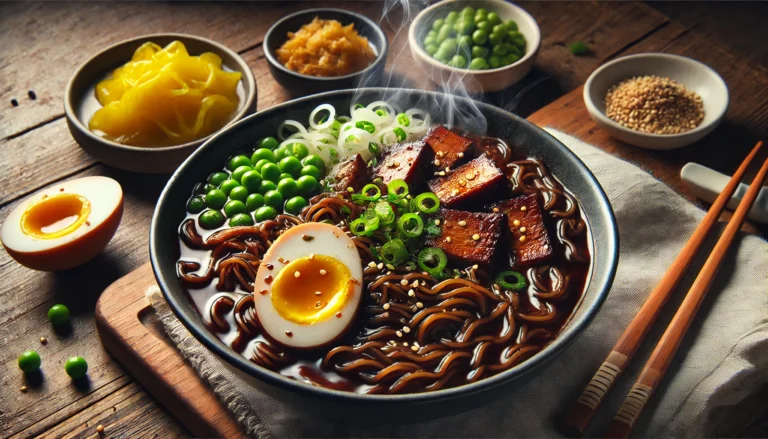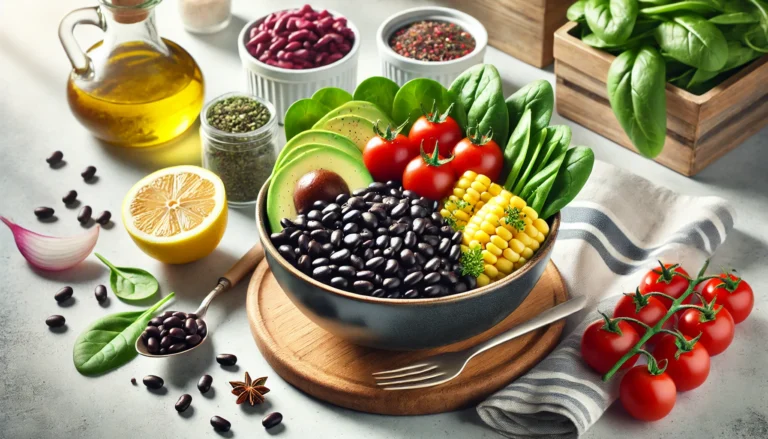Why Black Beans Are a Staple in Korean Jjajang Ramen and Beyond
If you’re wondering how to cook black beans the right way for your Korean dishes, especially jjajang ramen, you’re not alone! As a ramen lover (and full-time mukbang explorer 🍜), I’ve tried everything—from canned beans to slow-simmered dried ones. Black beans might seem simple, but they bring a rich, deep flavor that transforms jjajangmyeon into a warm, comforting bowl of umami magic.
In traditional Korean cuisine, black bean sauce (called “chunjang”) is made using fermented black soybeans, but when it comes to easy home versions of jjajang ramen, black beans can add that earthy richness without needing to be a chef.
Let’s say you’re making a midnight snack with easy black beans and instant noodles—sounds humble, right? But throw in a few black beans (cooked well and seasoned right), and boom! It turns into something you’d see in a K-drama comfort food scene 😋.
Here’s what makes black beans a kitchen hero:
🖤 Nutty, creamy texture
🖤 Natural umami flavor
🖤 Affordable and easy to store
🖤 A great protein source for plant-based eaters
Want to go beyond basic ramen? Try adding black beans into buldak ramen for a smoky + creamy twist. (I know, I know—it sounds crazy, but it totally works!) For ideas, check out 5 Best Ways to Enjoy Buldak Carbonara for Ultimate Flavor.
Whether you’re looking for a solid black bean recipe or just an easy black beans idea to jazz up your noodles, they belong in your pantry—always! Cooking black beans doesn’t have to be scary. Stick around, and I’ll walk you through every step.
Table of Contents
Choosing the Right Type of Black Beans for Flavor and Texture
Before you learn how to cook black beans perfectly, you need to know what kind to buy! There’s a big difference in flavor and cooking time depending on what you choose.
🥄 Dried black beans – These give you more control over flavor and texture. You can season them from the start, adjust softness, and they’re cheaper in bulk.
🥄 Canned black beans – Great when you’re in a rush. Already cooked, just rinse and warm. But some people find them a bit mushy or too salty.
So… which one should you pick? Here’s a quick guide:
🛒 For bold jjajang ramen with deep flavor: Go with dried beans, soaked overnight.
🛒 For buldak ramen side dishes or a quick upgrade: Use canned beans for that creamy richness with zero prep.
Now you’re probably asking, “Are black beans healthy?” Oh yes, they are! They’re packed with fiber, iron, and protein. For ramen lovers trying to balance indulgence and health, black beans give your bowl that extra bonus. It’s honestly the best way to cook black beans if you’re looking to boost flavor and nutrition in one go.
For more spicy ideas, you’ll love 7 Best Ways to Enjoy how to make buldak ramen less spicy with Amazing Flavor.
By the way, if you’re into learning food and language together (like I am), check out Learn English in 2025 | Top Methods for All Ages and Levels—a great resource while your beans are simmering!

How to Cook Black Beans for Jjajang Ramen: Soaking, Boiling, and Seasoning Tips
Here’s the fun part—how to cook black beans like a pro, even if it’s your first time! I’ll walk you through three steps: soaking, boiling, and seasoning.
🧂 Step 1: Soak
Why soak? It helps the beans cook evenly and reduces cooking time. Soak your dried black beans overnight (8–12 hours) in cool water. If you’re short on time, try the hot soak method—boil for 2 minutes, then let sit for 1 hour.
🔥 Step 2: Boil
Drain the soaked beans, put them in a pot, and cover with fresh water. Bring to a boil, then simmer gently for 60–90 minutes. Add a little kombu (dried kelp) for an umami boost—just like in ramen broth!
🌶️ Step 3: Season
Salt after cooking, not before! Add garlic, soy sauce, or sesame oil for that Korean-inspired twist. If you’re going for easy black beans, just mash and stir into your noodles or rice bowls.
Want more spicy and tangy flavor ideas? You’ll love 7 Best Ways to Enjoy habanero lime buldak with Amazing Flavor!
And while you’re cooking, practice your English listening with Learn English for Free in 2025 | Speak English with Ease—learning has never tasted this good 😉
Delicious Ways to Use Leftover Cooked Black Beans in Korean Dishes
Now that you know how to cook black beans, let’s talk about leftovers. I always cook extra and use them all week. Here’s how to make the most of them in Korean meals:
🥢 Black Bean Fried Rice – Mix black beans with kimchi and day-old rice. Top with a fried egg = heaven.
🥢 Ramen Topping – Add to Jin Ramen or spicy jjajang noodles for extra texture.
🥢 Korean-Style Burrito – Wrap beans, rice, bulgogi, and gochujang sauce in a tortilla. Fusion magic!
🥢 Bibimbap Twist – Swap out meat for beans in your bibimbap bowl.
🥢 Pajeon (Korean pancake) – Add black beans to your veggie pancake mix for a protein punch.
Want something bold and fusion-y? Try it with Curry Buldak! Seriously—see 5 Bold Ways Curry Buldak Adds Global Flair To Your Meal for wild inspiration.
And while you’re building your Korean cooking skills, practice your English too with Speak English with Ease | Learn English for Free in 2025.

Black Bean Shortcuts: Canned vs Dried and When to Use Each
Okay, let’s get real—sometimes, you don’t have 12 hours to soak beans. That’s where black bean shortcuts come in.
🥫 Canned Black Beans
✔️ Already cooked
✔️ Fast and easy
✔️ Great for emergencies
Just rinse to remove excess salt and they’re good to go. Use them when making ramen toppings or quick fried rice.
🫘 Dried Black Beans
✔️ Cheaper and more flavorful
✔️ Custom seasoning options
✔️ Perfect for soups, jjajang ramen, and bulk cooking
If you’re cooking black beans regularly, dried is the best way to cook black beans from scratch.
Health-wise, both are great. Just choose what fits your vibe today. And if you’re ever unsure, check out 8 Reasons Carbonara Noodles Buldak Are Worth Tasting Now to get inspired for a creamy, spicy ramen combo that pairs surprisingly well with black beans!
Is Jjajang Ramen Healthy? Nutritional Facts of Black Bean-Based Noodles
You might be wondering—if jjajang ramen tastes this good, can it really be healthy?
Well, if you add black beans, it gets a serious nutritional upgrade. Let’s break it down:
💪 Fiber – Keeps you full longer
💪 Protein – Supports muscle repair
💪 Iron + magnesium – Great for energy
So if you’re wondering how to cook black beans for the healthiest ramen experience, go with the boiling + garlic + soy sauce method. That keeps it clean and flavorful. Adding veggies like zucchini or onions can make it even better.
And for those curious about how instant ramen fits into a healthy diet, read more on Instant noodles—especially the Korean section!
Plus, black beans are naturally low-fat and gluten-free, making them ideal for gluten-sensitive ramen fans!
The Best Black Bean Ramen Brands You Can Try at Home Today
Now that you’ve mastered how to cook black beans, let me share some of my favorite jjajang ramen brands with real depth of flavor!
🥇 Ottogi Jjajang Ramen – Mild and slightly sweet; kid-friendly
🥈 Paldo Jjajangmen – Thicker noodles and more intense sauce
🥉 Nongshim Chapagetti – Classic Korean comfort food
🌶️ Samyang Spicy Jjajang – For spice lovers only!
🍜 Veggie Garden Black Bean Ramen – Vegan-friendly and hearty
These brands are easy to find online or in Korean grocery stores. Each one has a slightly different taste and noodle style, so explore and find your fave!
Want to get in touch or ask me which ramen I’m slurping this week? Hit me up at Contact Us | KoreanRamen.net and let’s talk noodles!
Related Posts

5 Best Ways to Enjoy Buldak Carbonara for Ultimate Flavor
Discover 5 delicious ways to enjoy buldak carbonara. Learn the best recipes, toppings, and sauces to make your spicy meal unforgettable.

6 Delicious Ways to Serve Cream Carbonara Buldak Tonight
6 Delicious Ways to Serve Cream Carbonara Buldak Tonight (cream-carbonara-buldak) Cream carbonara buldak is a real treat if you’re looking to spice up your mealtime

How to Make Carbonara Buldak: 4 Easy Steps to Spicy Delight
The Secret Behind Carbonara Buldak: A Perfect Fusion of Spicy and Creamy Carbonara Buldak combines the heat of traditional spicy Korean noodles with the rich
For any inquiries, feel free to Contact Us.
You can find all our posts about Buldak Ramen here.
This blog is written in English and you might need to learn English for better understanding. You can practice Spoken English here with LiveEnglishClass.
